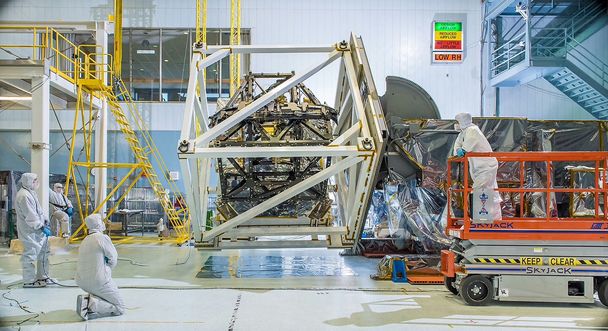James Webb Space Telescope moving forward – latest milestone for Airbus contributions to the mission

Summary
- James Webb telescope and instrument module shipped by NASA from Goddard Space Flight Centre in Washington to Johnson Space Centre in Houston for final tests
Houston 08/05/2017 – OTIS (Optical Telescope Element and Integrated Science), the payload module hosting the telescope and the instruments for the giant James Webb Space Telescope (JWST) has been shipped by NASA to the Johnson Space Centre (JSC) in Houston, Texas. OTIS includes two European instruments with major Airbus contributions, the near-infrared spectrograph NIRSpec built by Airbus and the mid-infrared instrument MIRI built with the support of Airbus.
NIRSpec, weighing 200kg, will be able to detect the faintest radiation from the most distant galaxies, observing more than 100 of them simultaneously. It will observe large samples of galaxies and stars at unprecedented depths across large swathes of the Universe and far back in time. Once launched, NIRSpec, known as the ‘super eye’, will operate at a temperature of -238°C. The instrument was developed by Airbus for the European Space Agency (ESA).
The MIRI instrument is a combined camera, spectrograph and coronagraph for mid-infrared wavelengths that will extend JWST’s observation capabilities to longer wavelengths, vital for the study of light from objects in the early universe or to peer inside dust clouds where stars and planetary systems are forming today. MIRI was developed by a European consortium of 21 institutes from 10 ESA member states as well as NASA’s Jet Propulsion Laboratory and Goddard Space Flight Centre, led by the UK’s Astronomy Technology Centre with project management from Airbus.
“This is a fantastic next step for the James Webb Space Telescope – bringing it one step closer to launch on Ariane 5,” said Nicolas Chamussy, Head of Space Systems. “JWST will enable us to study the early Universe and peer inside dust clouds to study star formation. This spacecraft represents the pinnacle of technology for modern astronomy, and shows Airbus’ outstanding expertise in support of the scientific research that JWST will carry out.”
NASA, ESA, and the Canadian Space Agency (CSA) are collaborating to develop JWST, designed to be the next step after the legendary Hubble Space Telescope. After its launch in 2018 on an Ariane 5 launcher from Europe’s spaceport in Kourou, French Guiana, JWST will be the largest astronomical telescope in space. It will be able to study key phases in the evolution of the Universe in great detail – from the formation of the first stars and galaxies only a few hundred millions years after the Big Bang to the formation of planetary systems in our own Milky Way galaxy today.
About Airbus
Airbus is a global leader in aeronautics, space and related services. In 2016, it generated revenues of € 67 billion and employed a workforce of around 134,000. Airbus offers the most comprehensive range of passenger airliners from 100 to more than 600 seats. Airbus is also a European leader providing tanker, combat, transport and mission aircraft, as well as Europe’s number one space enterprise and the world’s second largest space business. In helicopters, Airbus provides the most efficient civil and military rotorcraft solutions worldwide.